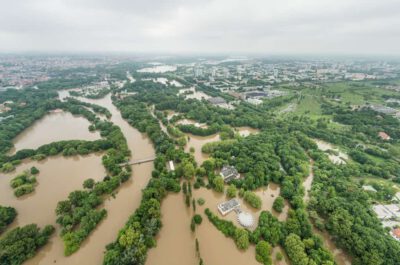
A new study in Science Advances finds that compounding effects of flood drivers can complicate and exacerbate the risk of extreme floods in watersheds around the world. DRI's Guo Yu, Ph.D., assistant research professor of hydrometeorology, co-authored the research.
“This study demonstrates how machine learning can help disentangle the complex interactions of different flood drivers,” Yu says. “We found that extreme floods can be caused by a combination of drivers with moderate magnitudes, rather than a single driver with extreme magnitude. This emphasizes the importance of understanding each individual flood driver in future research.”
Read the full press release from UFZ Helmholtz Centre for Environmental Research:
If rivers overflow their banks, the consequences can be devastating – just like the catastrophic floods in North Rhine-Westphalia and Rhineland-Palatinate of 2021 showed. In order to limit flood damage and optimise flood risk assessment, we need to better understand what factors can lead to extreme forms of flooding and to what extent. Using methods of explainable machine learning, researchers at the Helmholtz Centre for Environmental Research (UFZ) have shown that floods are more extreme when several factors are involved in their development. The research was published in Science Advances.
The interaction of several factors plays an important role in the development of floods. If in a catchment floods are more extreme the more variables are involved, then this catchment has a high flood complexity. In Germany, the upper reaches of the Elbe, the Saale and the Moselle are examples of catchments with a high flood complexity. In contrast, the Havel and the Zusam (a tributary of the Danube) are examples of catchments with a low flood complexity.
There are several factors that play an important role in the development of floods: air temperature, soil moisture, snow depth, and the daily precipitation in the days before a flood. In order to better understand how individual factors contribute to flooding, UFZ researchers examined more than 3,500 river basins worldwide and analysed flood events between 1981 and 2020 for each of them. The result: precipitation was the sole determining factor in only around 25% of the almost 125,000 flood events. Soil moisture was the decisive factor in just over 10% of cases, and snow melt and air temperature were the sole factors in only around 3% of cases. In contrast, 51.6% of cases were caused by at least two factors. At around 23%, the combination of precipitation and soil moisture occurs most frequently.
However, when analysing the data, the UFZ researchers discovered that three – or even all four – factors can be jointly responsible for a flood event. For example, temperature, soil moisture, and snow depth were decisive factors in around 5,000 floods whilst all four factors were decisive in around 1,000 flood events. And not only that: “We also showed that flood events become more extreme when more factors are involved”, says Dr Jakob Zscheischler, Head of the UFZ Department “Compound Environmental Risks” and senior author of the article. In the case of one-year floods, 51.6% can be attributed to several factors; in the case of five- and ten-year floods, 70.1% and 71.3% respectively can be attributed to several factors. The more extreme a flood is, the more driving factors there are and the more likely they are to interact in the event generation. This correlation often also applies to individual river basins and is referred to as flood complexity.
read more www.dri.edu/a-fresh-look-at-the-drivers-of-extreme-flooding/
Helmholtz-Zentrum für Umweltforschung GmbH – UFZ
www.ufz.de








